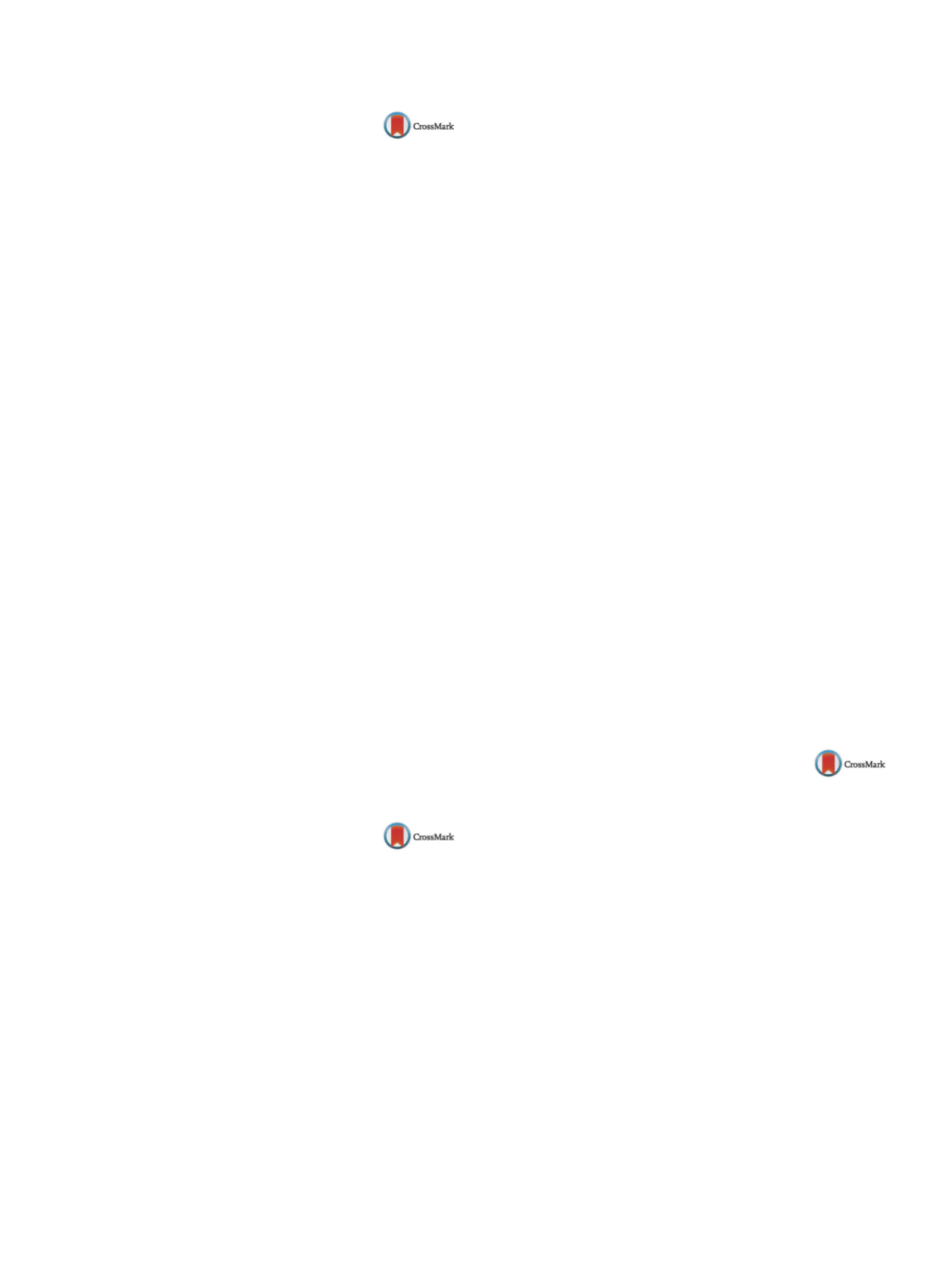

S646
25th European Congress of Psychiatry / European Psychiatry 41S (2017) S645–S709
EV0741
A Case of erotomanic delusion in
dementia
M. Arts
1 ,∗
, S. Petrykiv
2, J. Fennema
3, L. De Jonge
41
University of Groningen, University Medical Center Groningen,
Department of Old Age Psychiatry, Groningen, The Netherlands
2
University of Groningen, University Medical Center Groningen,
Department of Clinical Pharmacy and Pharmacology, Groningen, The
Netherlands
3
GGZ Friesland, Geriatric Psychiatry, Leeuwarden, The Netherlands
4
Leonardo Scientific Research Institute, Geriatric Psychiatry,
Groningen, The Netherlands
∗
Corresponding author.
Introduction
In dementia, delusions are common with preva-
lence up to 75%. However, erotomanic delusions, or De Cler-
ambault’s syndrome, are a rarity in dementia. To date, only six
case-reports have been described in vascular dementia, frontotem-
poral dementia, and Alzheimer’s dementia.
Objectives
To present a case of De Clerambault’s syndrome in an
older adult diagnosed with vascular dementia.
Aims
To review available literature on De Clerambault’s syn-
drome in dementia.
Methods
A case report is presented and discussed followed by a
literature review.
Results
We report a 72-year-old female with a history of right
posterior cerebral artery infarction. The patient developed a sud-
den onset erotomanic delusion after she met a male patient of her
age during her stay in a dementia day care center. She was agi-
tated, disorientated, presented with confabulation, and showed a
dysphoric mood. On MMSE she scored 14/30, the clock-drawing
test revealed visuospatial deficits. On MRI, the right occipital lobe
showed an encephalomalacia. The patient was treated with sertra-
line 50mg/day and olanzapine 5mg/day. Her erotomanic delusions
improved after 3months of treatment.
Conclusion
De Clerambault’s syndrome is a rare and poorly
understood disorder with generally a poor response to treatment.
Some cases were successfully treatedwith atypical anti-psychotics.
However, further research is needed to explore the course and
treatment of this delusion.
Disclosure of interest
The authors have not supplied their decla-
ration of competing interest.
http://dx.doi.org/10.1016/j.eurpsy.2017.01.1071EV0742
Late life depression, postural
instability and dyspnea: The He.s.i.o.d.
study (Hexameter study in older
depressed)
M. Belvederi Murri
1 ,∗
, E. Nerozzi
2, N. Padula
3, C. Tacconi
4,
A. Coni
5, L. Chiari
5, B. Assirelli
6, G. Toni
7, R. Chattat
8,
T. Ferdinando
9, F. Neviani
10, A. Cremonini
11, M. Amore
1,
S. Zanetidou
11, K.D. Bertakis
121
Clinica Psichiatrica, Dinogmi, Genoa, Italy
2
School of Pharmacy, Biotechnology and Sport Science, Bologna, Italy
3
Sport Science Professional, Private sector, Bologna, Italy
4
University of Bologna, Health Sciences and
Technologies-Interdepartmental Center for Industrial Research
HST-ICIR, Bologna, Italy
5
University of Bologna, Department of Electronics, Computer Science
and Systems, Bologna, Italy
6
Primary Care Physician, Private practice, Bologna, Italy
7
Correggio Hospital, Unit of Cardiology, Correggio, Italy
8
University of Bologna, Department of Psychology, Bologna, Italy
9
Unit of Sports Medicine, Department of Public Health, Modena, Italy
10
University of Modena and Reggio Emilia, Geriatrics Department,
Modena, Italy
11
Psychiatric Consultation Service for Primary Care, Department of
Mental Health, Bologna, Italy
12
U.C. Davis, Department of Family and Community Medicine,
Sacramento, CA, USA
∗
Corresponding author.
Introduction
Late life major depression (LLMD) is usually treated
within primary care, but still with unsatisfactory outcomes and sig-
nificant residual symptoms. Moreover, LLMD increases symptoms
of anxiety, dyspnea, fear of falling (FOF), and risk of falls. Evidence
fromnon-depressed patients suggests the efficacy of breathing and
postural exercises; in particular, rhythmic breathing during poetry
recitation was shown to improve cardio-respiratory synchroniza-
tion. Thus, the aim of the HESIOD study was to test the efficacy of
antidepressants plus breathing and postural exercises to improve
patients’ anxiety mood, dyspnea, FOF, and postural stability.
Methods
Two non-randomised groups were compared: (1)
antidepressant drugs plus weekly sessions of breathing/postural
exercises based on the rhythmic recitation of hexameter poetry
(intervention); (2) antidepressant drugs plus weekly sessions of
group reading (comparator). Patients aged 65 +, with non-psychotic
recurrent LLMD were recruited from a psychiatric consultation-
liaison program for primary care. The main outcome measure was
remission from depression (MADRS score
≤
10) at 24weeks. Sec-
ondary outcomes will include accelerometer-based measures of
postural stability; patient-rated dyspnea, and FOF.
Results
Preliminary data on 34 patients show that patients
receiving breathing and postural exercises displayed greater remis-
sion rates than those in the reading group (47.1% vs. 11.8%,
P
= 0.02).
Further analyses will examine the effects on postural stability, dys-
pnea and FOF.
Conclusions
Breathing and postural exercises may exert signifi-
cant clinical advantage when added to the standard antidepressant
drug therapy for LLMD. This study might prompt further research
on innovative treatment strategies to improve the outcomes of late
life depression in primary care.
Disclosure of interest
The authors have not supplied their decla-
ration of competing interest.
http://dx.doi.org/10.1016/j.eurpsy.2017.01.1072EV0743
The adherence to Mediterranean diet
moderates the association between
medical multi-morbidity and
depressive symptoms in elderly
outpatients
F.S. Bersani
1 ,∗
, R . Vicinanza
2 , E. d’Ottavio
2 , M.Biondi
1 ,M. Cacciafesta
2 , G.Troisi
21
Sapienza University of Rome, Department of Neurology and
Psychiatry, Roma, Italy
2
Sapienza University of Rome, Department of Cardiovascular,
Respiratory, Nephrologic, Anesthesiologic and Geriatric Sciences,
Roma, Italy
∗
Corresponding author.
Background
Depressive symptoms in the elderly are related to
the advancing of age, loss of life purpose, medical multi-morbidity,
cognitive decline and social-economic problems mounting evi-
dence suggests that lifestyle behaviors and certain dietary patterns
may improve mood and overall well-being in older adults. In the
present study we investigated (i) the association of adherence to
Med-Diet with depressive symptoms and multi-morbidity in a
cohort of geriatric medical outpatients and (ii) the role of Med-
Diet in mediating the association between depressive symptoms
and multi-morbidity.
Methods
Morbidity was assessed using the severity index of
cumulative illness rating scale for geriatrics (CIRSG-SI). Montreal
cognitive assessment (MoCA) and geriatric depression scale (GDS)


















